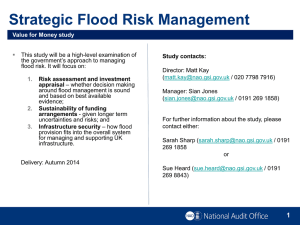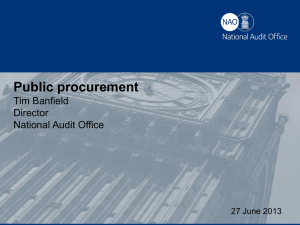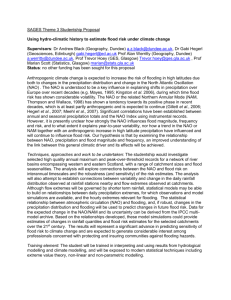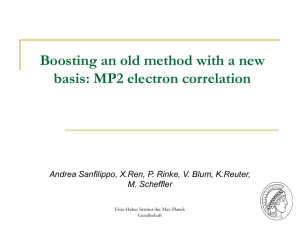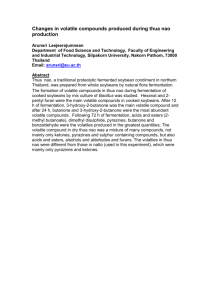exhanges.naobook
advertisement
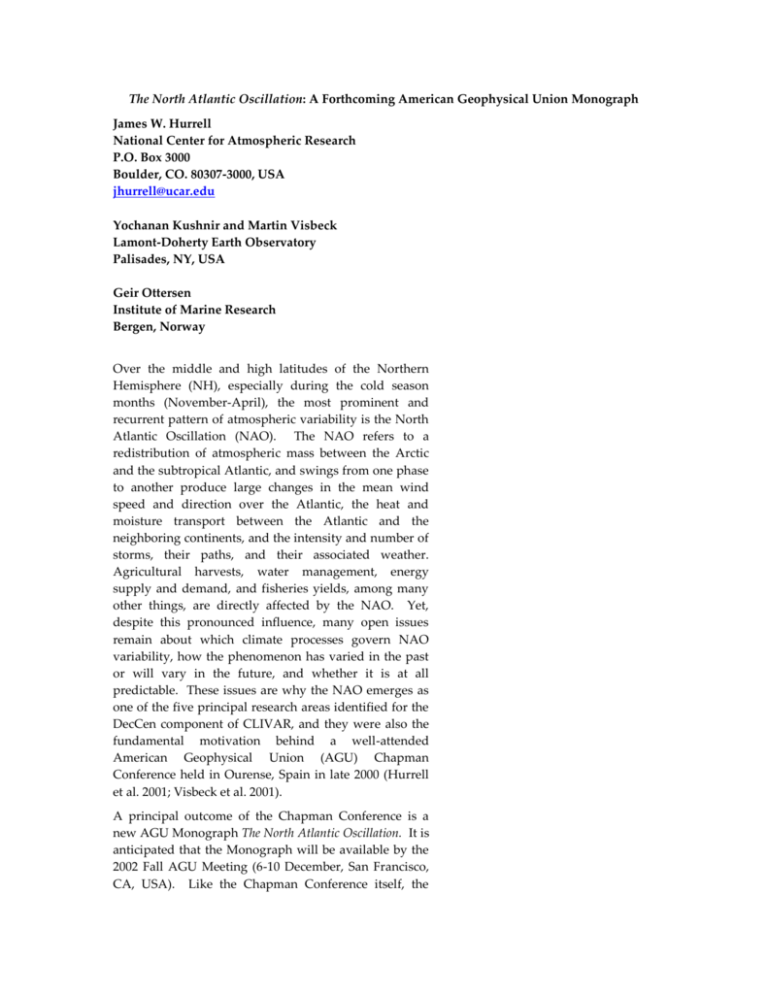
The North Atlantic Oscillation: A Forthcoming American Geophysical Union Monograph James W. Hurrell National Center for Atmospheric Research P.O. Box 3000 Boulder, CO. 80307-3000, USA jhurrell@ucar.edu Yochanan Kushnir and Martin Visbeck Lamont-Doherty Earth Observatory Palisades, NY, USA Geir Ottersen Institute of Marine Research Bergen, Norway Over the middle and high latitudes of the Northern Hemisphere (NH), especially during the cold season months (November-April), the most prominent and recurrent pattern of atmospheric variability is the North Atlantic Oscillation (NAO). The NAO refers to a redistribution of atmospheric mass between the Arctic and the subtropical Atlantic, and swings from one phase to another produce large changes in the mean wind speed and direction over the Atlantic, the heat and moisture transport between the Atlantic and the neighboring continents, and the intensity and number of storms, their paths, and their associated weather. Agricultural harvests, water management, energy supply and demand, and fisheries yields, among many other things, are directly affected by the NAO. Yet, despite this pronounced influence, many open issues remain about which climate processes govern NAO variability, how the phenomenon has varied in the past or will vary in the future, and whether it is at all predictable. These issues are why the NAO emerges as one of the five principal research areas identified for the DecCen component of CLIVAR, and they were also the fundamental motivation behind a well-attended American Geophysical Union (AGU) Chapman Conference held in Ourense, Spain in late 2000 (Hurrell et al. 2001; Visbeck et al. 2001). A principal outcome of the Chapman Conference is a new AGU Monograph The North Atlantic Oscillation. It is anticipated that the Monograph will be available by the 2002 Fall AGU Meeting (6-10 December, San Francisco, CA, USA). Like the Chapman Conference itself, the Monograph brings together atmospheric scientists, oceanographers, paleoclimatologists and biologists to focus exclusively on the NAO and present a state-of-theart assessment of current understanding of this important climate phenomenon. Indeed, the outstanding feature of the Monograph is its multidisciplinary content. The Monograph is thematically organized and provides a comprehensive (multidisciplinary) overview of material (theory, observations and models) related to the NAO. There are 12 chapters, each presenting a thorough overview of a topic, and most contain new research as well. Each chapter was subjected to critical peer review and was revised accordingly. A total of 36 expert referees made substantial contributions to the overall quality and content of the Monograph. The NAO is one of the oldest known world weather patterns, as some of the earliest descriptions of it were from seafaring Scandinavians several centuries ago. Indeed, the history of scientific research on the NAO is rich, and Stephenson et al. (2002) present a stimulating account of the major scientific landmarks of NAO research through time. They also note that, today, there is considerable renewed interest in the phenomenon, and it is this renewed interest that is the focal point for much of the Monograph. The NAO and its time dependence, for instance, appear central to the current global change debate. Surface temperatures over the NH are likely to be warmer now than at any other time over the past millennium, and a substantial fraction of this most recent warming is linked to the behavior of the NAO, in particular a trend in its winter index from large amplitude anomalies of one phase in the 1960s to large amplitude anomalies of the opposite phase since the early 1980s. Gillett et al. (2002) assess whether this change in the atmospheric circulation of the North Atlantic is beyond natural variability, and they synthesize a diverse body of literature dealing with how the NAO might change in response to increasing concentrations of greenhouse gases. The relationship between the NAO and anthropogenic climate change has also made it critical to better understand how the NAO and its influence on surface climate have varied naturally in the past. Jones et al. (2002) assess this issue using long, mostly European instrumental records, and they conclude by demonstrating the potential of a new instrumental index dating back to the late 17th century. The need for longer NAO records has also led to the development of numerous extensions from paleoclimate proxies, and Cook (2002) critically reviews these attempts. He also presents a new winter NAO index reconstruction back to AD 1400. Another reason for invigorated interest in the NAO is that the richly complex and differential responses of the surface-, intermediate- and deep-layers of the ocean to NAO-induced forcing are becoming better documented and understood. The intensity of wintertime convective renewal of intermediate and deep waters in the Labrador Sea and the Greenland-Iceland-Norwegian Seas, for instance, is not only characterized by large interannual variability, but also by interdecadal variations that appear to be synchronized with fluctuations in the NAO. These changes in turn affect the strength and character of the Atlantic thermohaline circulation and the horizontal flow of the upper ocean, thereby altering the oceanic poleward heat transport and the distribution of sea surface temperature (SST). Visbeck et al. (2002) review what is known about the oceanic response to changes in NAO forcing from theoretical, numerical experimentation and observational perspectives. They note that the ocean can respond to NAO-induced forcing with marked persistence or even oscillatory behavior. The extent to which the influence of such oceanic behavior affects the evolution and dynamical properties of the atmospheric flow is probably small, but that it is perhaps significant has stimulated much interest and ongoing work. Czaja et al. (2002) assess the relevance of ocean-atmosphere coupling in determining the overall variability of the NAO. That the ocean may play an active role in determining the evolution of the NAO is also one pathway by which some limited predictability might exist. New statistical analyses have revealed patterns in North Atlantic SSTs that precede specific phases of the NAO by 6-9 months, a link that likely involves the remarkable tendency of the extratropical ocean to preserve its thermal state throughout the year. On longer time scales, recent modeling evidence suggests that the NAO responds to slow changes in global ocean temperatures, with changes in the equatorial regions perhaps playing a central role. Rodwell (2002) reviews and investigates the predictive role of the ocean circulation using observational, atmospheric and coupled model data, and makes the point that even a limited amount of NAO predictability could be useful. A second pathway that offers hope for improved predictability of the NAO involves links through which changes in stratospheric wind patterns might exert some downward control on surface climate. A statistical connection between the month-to-month variability of the NH stratospheric polar vortex and the tropospheric NAO was established several years ago, and more recently it has been documented that large amplitude anomalies in the wintertime stratospheric winds precede anomalous behavior of the NAO by 1-2 weeks, perhaps providing some useful extended-range predictability. Thompson et al. (2002) discuss the mechanisms by which the stratosphere might drive NAO-like variability, and they also examine the more dominant tropospheric processes that account for most of the variance of the NAO. Of relevance for the latter is the recasting of the NAO as a regional expression of an annular, hemispheric mode of variability, known as the Northern Annular Mode. Renewed interest in the NAO has also come from the biological community. Variations in climate have a profound influence on a variety of ecological processes and, consequently, patterns of species abundance and dynamics. Fluctuations in temperature and salinity, vertical mixing, circulation patterns and ice formation of the North Atlantic Ocean induced by variations in the NAO have a demonstrated influence on marine biology and fish stocks through both direct and indirect pathways. The response of marine ecosystems to climate variability associated with the NAO is thoroughly reviewed by Drinkwater et al. (2002). Responses of terrestrial ecosystems to NAO fluctuations have also been documented. In parts of Europe, for example, many plant species have been blooming earlier and longer because of increasingly warm and wet winters, and variations in the NAO are also significantly correlated with the growth, development, fertility and demographic trends of many land animals. Mysterud et al. (2002) review the known effects of the NAO on processes and patterns of terrestrial ecosystems. The NAO has a demonstrated influence on the physics, hydrology, chemistry and biology of freshwater ecosystems as well. Straile et al. (2002) show that the physical impacts of the NAO include effects on lake temperature profiles, lake ice phenology, river runoff and lake water levels. These physical and hydrological responses influence the chemistry and biology of lakes across the NH, so ultimately the population dynamics of freshwater organisms on several trophic levels are affected by climate variability associated with the NAO. Finally, Hurrell et al. (2002) present an overview and general discussion of the NAO aimed specifically for the non-specialist. In this introductory chapter, they describe the spatial structure of climate and climate variability, and how the NAO relates to other, prominent patterns of atmospheric circulation variability. They also describe the impact of the NAO on surface temperature, precipitation, and storms, as well as highlight the ocean and ecosystem responses, and the mechanisms that govern NAO variability. They conclude with some thoughts on outstanding issues and future research challenges. We, the editors, are confident that the Monograph represents a current and an authoritative survey of the ever-growing body of literature on the NAO. It is unique: no other such volume on the NAO exists. As such, we hope it is a valuable resource for students and researchers alike. Book Reference and Chapters The North Atlantic Oscillation, J. W. Hurrell, Y. Kushnir, G. Ottersen, M. Visbeck, (Eds.), AGU, in press. Cook, E. R., 2002: Multi-proxy reconstructions of the North Atlantic Oscillation (NAO) index: A critical review and a new well-verified winter index reconstruction back to AD 1400. Czaja, A., A. W. Robertson, and T. Huck, 2002: The role of Atlantic ocean-atmosphere coupling in affecting North Atlantic Oscillation variability. Drinkwater, K. F., and co-authors, 2002: The response of marine ecosystems to climate variability associated with the North Atlantic Oscillation. Gillett, N. P., H. F. Graf, and T. J. Osborn, 2002: Climate change and the North Atlantic Oscillation. Hurrell, J. W., Y. Kushnir, G. Ottersen, and M. Visbeck, 2002: An overview of the North Atlantic Oscillation. Jones, P. D., T. J. Osborn, and K. R. Briffa, 2002: Pressure-based measures of the North Atlantic Oscillation (NAO): A comparison and an assessment of changes in the strength of the NAO and in its influence on surface climate parameters. Mysterud, A., N. C. Stenseth, N. G. Yoccoz, G. Ottersen, and R. Langvatn, 2002: The response of terrestrial ecosystems to climate variability associated with the North Atlantic Oscillation. Rodwell, M. J., 2002: Atlantic climate. On the predictability of North Stephenson, D. B., H. Wanner, S. Brönnimann, and J. Luterbacher, 2002: The history of scientific research on the North Atlantic Oscillation. Straile, D., D. M. Livingstone, G. A. Weyhenmeyer, and D. G. George, 2002: The response of marine ecosystems to climate variability associated with the North Atlantic Oscillation. Thompson, D. W. J., S. Lee, and M. P. Baldwin, 2002: Atmospheric processes governing the Northern Hemisphere Annular Mode/North Atlantic Oscillation. Visbeck, M., E. .P. Chassignet, R. Curry, T. Delworth, B. Dickson, and G. Krahmann, 2002: The ocean’s response to North Atlantic Oscillation variability. Other References Hurrell, J. W., Y. Kushnir, and M. Visbeck, 2001: The North Atlantic Oscillation. Science, 291, 603-605. Visbeck, M. J. W. Hurrell, and Y. Kushnir, 2001: First international conference on the North Atlantic Oscillation (NAO): Lessons and challenges for CLIVAR. CLIVAR Exchanges, 6, 24-25.
